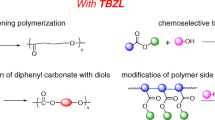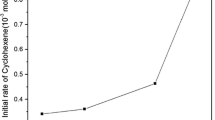Summary
The palladium-catalyzed three-component coupling reaction of acetylenes, aryl halides, and hydride and it’s application to polymer synthesis are described. The coupling reaction of 1,2-diphenylacetylene, iodobenzene, and sodium diethyl benzylmalonate was carried out at 80°C for 48 h in 1,4-dioxane with Pd(OAc)2 / tri-o-tolylphosphine, from which triphenylethylene was obtained in 71% isolated yield. The benzylic hydrogen of sodium diethyl benzylmalonate was supposed to be a hydride source in the present reaction by detecting diethyl benzalmalonate in the reaction system. Based on the results, the coupling polymerization of l,2-bis(4-phenylethynylphenyl) ethane, 4,4′-diiodobiphenyl, and sodium diethyl benzylmalonate was carried out at 80°C for 48 h to produce a polymer (Mn= 8500, Mw / Mn = 3.0) in high yield. Using various aryl dihalides, the corresponding polymers having trisubstituted ethylene units were also obtained in high yields.
Similar content being viewed by others
References and Notes
Luneva LK, Sladlov AM, Korshak VV (1965) Vyskomol Soedin 7: 427
Chujo Y, Tomita I, Hashiguchi Y, Saegusa T (1990) Macromolecules 23: 687
Kobayashi E, Metaka N, Aoshima S, Furukawa J (1990) J Polym Sci: Part A: Polym Chem 28: 2461
Kobayashi E, Jiang J, Ohta H, Furukawa J (1992) J Polym Sci: Part A: Polym Chem 30: 227
Chujo Y, Tomita I, Saegusa T (1992) Polym Bull 27: 375
Kuroda H, Tomita I, Endo T (1995) Macromolecules 28: 433
Kuroda H, Tomita I, Endo T (1995) Macromolecules 28: 6020
Miyaki N, Tomita I, Endo T (1996) Macromolecules 29: 6685
idem (1997) J Polym Sci: Part A: Polym Chem 35: 1211
idem (1997) J Polym Sci: Part A: Polym Chem 35: 2097
Miyaki N, Tomita I, Endo T idem (1997) Chem Lett 685
idem (1997) Macromolecules 30: 4504
Perlmutter P (1992) Conjugate Addition Reaction in Organic Synthesis. Pergamon: Oxford
Trost BM (1991) Comprehensive Organic Synthesis Vol. 4. Pergamon: Oxford
Cacchi S, Flelici M, Pietroni B (1984) Tetrahedron Lett 25: 3137
Arcadi A, Cacchi S, Marinelli F (1985) Tetrahedron 41: 5121
Arcadi A, Cacchi S, Marinelli F (1986) Tetrahedron Lett 27: 6397
Arcadi A, Bernocchi E, Burini A, Cacchi S, Marinelli F, Pietroni B (1988) Tetrahedron 44: 481
Arcadi A, Bernocchi E, Burini A, Cacchi S, Marinelli F, Pietroni B (1989) Tetrahedron Lett 30: 3465
In the case of the reaction with 3b, the starting material (i.e., 1,2-diphenylethylene) was recovered in 61% yield.
Trost BM (1977) Tetrahedron 33: 2615
For the review related to the mechanisms on the Pd-catalyzed reactions, see: (a) Ram S, Ehrenkaufer RE (1988) Synthesis 91
Tsuji J, Shimizu I (1990) J Synth Org Chem Jpn 48: 1016
A white powdery polymer could be isolated when the polymer was purified further by HPLC. Thus, the pale yellow color observed for the polymer after precipitation is originated from any contaminants (e.g., the palladium catalyst).
The small peaks appeared at 6.5 ppm in the 1H-NMR spectrum might be attributed to the protons in the diene unit produced by the double insertion of the acetylene moieties. From the detailed analysis of the minor products in the model reaction of 1,2-diphenylacetylene, p- iodotoluene, and sodium diethyl benzylmalonate (3a), as described above, 1-p-tolyl-l,2,3,4-tetraphenyl-l,3-butadiene (i.e., a double insertion product of the acetylene to the arylpalladium species) was isolated in 19% yield (based on 1,2-diphenylacetylene) beside the major product. Although this result indicates the presence of the branched unit in 5a by means of the double insertion of the acetylene moieties, no gelation was observed unless the polymerization was carried out with an excess amount of the diyne.
The double insertion process was detected as a side reaction in the model experiment. See, ref. (8).
Author information
Authors and Affiliations
Rights and permissions
About this article
Cite this article
Miyaki, N., Tomita, I. & Endo, T. Palladium-catalyzed three-component coupling. Polymer Bulletin 39, 677–684 (1997). https://doi.org/10.1007/s002890050202
Received:
Revised:
Accepted:
Issue Date:
DOI: https://doi.org/10.1007/s002890050202




